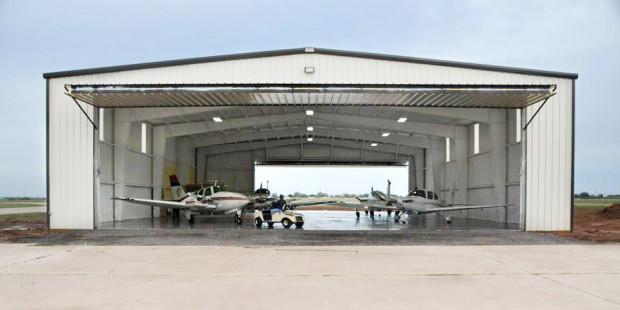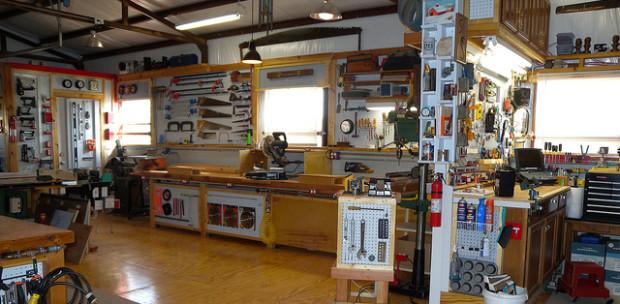An Insider on Steel Airplane Hangars

It’s sleek.
It’s lightweight.
It’s sturdy.
It’s modern and retains or increases in value the longer you have it.
Polished metal, brilliant color, without saying a single word it screams that you’ve made it and you love flying.
But it isn’t your new plane, it’s your hangar, and it’s made of steel.
Hangars have always been as to the aviation industry as the jet or prop plane parked inside. Your hangar says as much about you as your plane does. From the early days of pole barns with gravel floors which housed rural crop dusters to the tricked out lounge-office-laboratory-type enclosures constructed for private luxury jets, your hangar is not only a practical home for your air-borne investment, but a bold confirmation that you take flying seriously.
You need to understand the essentials of a steel airplane hangar. Steel is inexpensive but sustains or increases in value because unlike wood or brick and mortar buildings, it maintains aesthetics and it functions well into maturity.
Before you embark on a steel hangar solution, however, you should know the price of steel fluctuates with the market. It’s a manufactured resource and is subject to the same market forces that determine the price of everything from pork bellies to refined oil. Supply and demand, material costs, and transportation play significant roles in the cost of raw steel. The good news is that, despite a sometimes volatile economy, the fluctuations in the price of steel are relatively minor when compared to other manufactured materials.
Airplanes are a modern mode of transportation. The sight of an airplane from any generation triggers the brain into thoughts of gliding to new places; the necessary aerodynamics provide a fluid-looking machine that has engendered itself to the psyche of modern-man with all things contemporary. The lightness and pliancy of a steel hangar behaves the same way – especially in comparison to a wood or brick building.
Hangars are remarkably cost efficient and it’s likely that, regardless of your day job, you have the construction knowledge to understand the erection drawings that accompany your hangar and may even have the time to erect the building on your own, with minimal assistance from a contractor. A pre-engineered steel hangar is delivered pre-engineered; each part is pre-cut and pre-drilled with precision, requiring no need for the seasoned and possibly expensive skills of a carpenter or mason.
Pre-engineered steel hangar systems don’t require that you pay for an architect. Detailers and engineers who specialize in steel buildings take great pride in their ability to deliver creative and attractive hangars which are not only designed, but engineered in accordance with your region’s snow and wind load requirements. This is going to give you flexibility with your particular flair as well as eliminate the time and expense associated with a traditional ‘architect then engineer’ team. Although architects can be talented and creative, in the steel building industry we maintain that a talented building expert can provide you with the same marriage of attractiveness and function as an architect – especially when it comes to a hangar.
Does this mean you are going to receive a cookie-cutter box-shaped building, devoid of the personal options you might expect from a hangar designed by an architect and assembled by a team of contractors?
Absolutely not.
Modern technology and the detailing and engineering capabilities of reputable steel building companies have given rise to a list of aesthetic and functional options which will ensure that your hangar is a reflection of your taste, style, and overall groove.
But aside from the cost and ease of construction, a steel hangar has other benefits. Steel hangars have an almost limitless interior span. This means that you can choose to purchase a hangar with no interior columns – up to 300’ wide clearspan – accommodating large planes, multiple planes, or providing additional storage or workshop space. Unlike wood which gets exponentially more expensive with greater spans, modern steel construction allows for extremely cavernous spaces with no interior support beams to obstruct the working area while maintaining a fairly constant cost per foot.
Because of the fact that steel is lightweight and the way in which it distributes loads, steel hangars are easily constructed without traditional trusses in the ceiling. The roof purlins and rigid frames force the top loads to the exterior walls eliminating obstructions and providing for more cavernous interior spaces. The openness not only provides you significantly more room should you need maintenance equipment, cranes, or hoists but it also gives you the same kind of sky’s-the-limit sensation inside that you clearly enjoy outside.
You don’t have to skimp on the exterior look and feel either. For a simple design, steel lends itself to multicolored panel and trim finishes but you may want to consider wainscot or even faux brick or a stone façade. The money you save in material costs can be used liberally on creative finishes which match your taste, your neighboring structures or fit seamlessly into your landscape.
It’s possible you might be erecting a hangar in a remote location – this is one place where steel really ‘shines.’ Unlike a traditional build, a pre-engineered steel hangar arrives on-site, usually in one delivery, and ready for assembly. If you are erecting a hangar on an airfield, your hangar construction won’t be an intrusive time interruption. Your neighbors will appreciate this, if nothing else.
In terms of longevity, Mother Nature is a formidable foe to almost any building. Fortunately, steel boldly confronts the elemental abuse of most climates. Steel hangars are built with a certain amount of inherent deflection which means a steel building is engineered to be more forgiving in high wind areas, it is engineered to contest seismic activity, stand in all soil types, and even withstands snow accumulation loads with ease. In a nutshell, it doesn’t get tired the way wood beam construction does over time.
Maintenance on a steel building is almost non-existent. Wood is a natural material and susceptible to erosion, rotting, expansion or shrinkage without regular maintenance. Steel maintains its integrity despite the earth’s natural cycle of reduction and reconstruction. While you may need to give your hangar a ‘once-over’ every few years, the time you spend on maintenance is less per year than the time you spend maintaining your plane each and every flight.
You’ve got a lot to do! You enjoy flying, you enjoy being in the air. As a recreational flyer, myself, I know the great thrill of a take-off or a landing; the way your heart beats a special rhythm when you’re soaring through the clouds; the indescribable feeling of seeing the planet from a vantage that birds have jealously kept secret from us since the beginning of time.
No matter how you use your aircraft, your plane isn’t just a piece of property or a vehicle, it’s as relevant to your lifestyle as the way you use it – for work, recreation, pleasure, travel, or commerce. You need to protect that and what better way than a sharp looking pre-engineered steel hangar system?
« Healing with Horses: A Closer Look At Hippotherapy
30,000 Benefits of a Steel Building »
Popular Posts

It’s a place to unwind or maybe even escape. Yes, we’re talking about a man cave, and every man should have one. Sometimes it seems like the woman in your life has her stamp on every part of the house. Are you inundated with fluffy pillows? Are there scented candles or plastic-covered sofas in every… …

Are you shopping for a new metal building? Are you looking for a new workshop or garage for your property? If you are unsure of what material to build with, take a look at some of the reasons to build a pre-engineered metal building. New Technology, New Designs – When you build with steel, you aren’t limited… …

